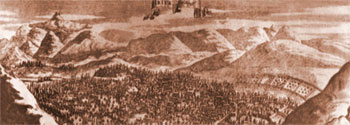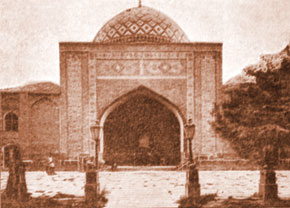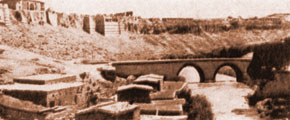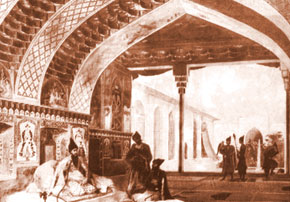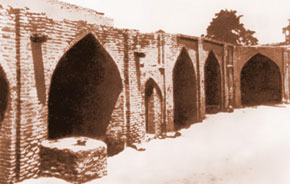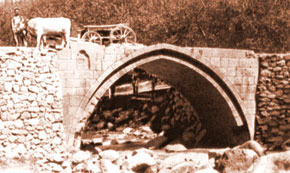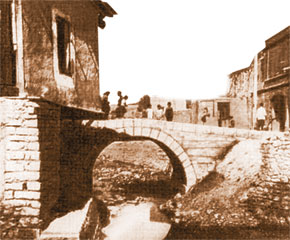Pages 82-85
by Rizvan Garabaghli
The city of Yerevan lies in a hollow surrounded by high mountains. Since it was founded by a celebrated clan leader called Sad, it was first named in his honour: “Sadchukhur” or “Chukhursad” (‘Sad’s Hollow’). According to the Azerbaijani traveller Shirvan, there was a strong fortress in Chukhursad surrounded by a bend in the river. The population of the city was almost wholly Azerbaijani. This was confirmed by the French traveller Jean-Baptist Tavernier.
Military architecture – the fortresses
According to historical sources, there were three fortresses in ancient Chukhursad. One was built in 1583 by the military leader, Farhad Pasha, on the bank of the Zengi river. This one was surrounded by water-filled ditches. Comparatively small fortresses, which acted as watchtowers, were constructed on hills to its south and west. Another fortress, near the Farhad Pasha Fortress, was constructed by the commanders of Nakhchivan. According to Isgender Munshi, this fortress was founded in 1605 by Mollah Abdulbaghi. Like the others it had strong walls and ditches filled with water. There is very little information about the Shorapal fortress. Sources say that it was destroyed by order of Shah Abbas I. Although Chukhursad fortresses were built and destroyed many times over the years, their names were always associated with the Gizilbash clan.
Evliya Chalabi the renowned Turkish traveller, recorded that in 915(Hegira), 1509/1510 AD, Shah Ismayil Safavi ordered his vizier, Ravan Gulu Khan, to build a fortress on the site of the present city of Yerevan, along the right bank of the Zengi river. It was completed in 7 years.
This fortress had three gates, “Tabriz Gate”, “Shirvan Gate”, “Korpu (Bridge) gate” and four quarters, “Gala (Fortress)”, “Sheher (City)”, “Tepebashi (Top of the hill)” and “Damirbulag (Iron Spring)”. (The walls of this fortress were completely levelled in 1864).
Religious architecture – the mosques
Mosques with tall minarets were distinguishing features of Yerevan’s silhouette. In all, there were eight mosques functioning in the city up to the beginning of the 20th century; four of them were in the “Sheher” quarter: the mosques of “Novruz Ali khan”, “Huseyn Ali khan” (the Blue Mosque), “Khoja Safarbey” and “Muhammad Sartibkhan”.
In 1604, after Shah Abbas I had liberated the Yerevan fortress from the Ottomans, he constructed a grand mosque on the south side of the Sardar Palace. The architect of this mosque, completed in 1606, was a famous craftsman of the time, Sheykh Baheddin.
The Yerevan Mosque complex, similar in construction to the Ganja Mosque, included a madrasah, a library, a hostel and buildings of various destinations. The mosque and its buildings were still there in 1918, albeit in dilapidated condition. However, they were completely destroyed later.
Rajab Pasha constructed a new mosque in the Yerevan Fortress in 1725.
The architecture of a mosque built by Abbas Mirzah amazed all by its beauty. But when the Russians occupied Yerevan in 1827, Abbas Mirzah’s mosque was completely destroyed; and a Russian church was built in place of the mosque constructed by Rajab Pasha. The Huseyn Ali Khan mosque, also known as the Blue Mosque, had four minarets. Three of them were destroyed after World War II, but even with a single minaret, the Blue Mosque was a centre of attraction until recently.
The oldest mosque in the Yerevan Fortress was built in 1510, by order of Shah Ismayil. In 1918 Armenians drove Muslims into this mosque and set fire to it. The mosque and the people inside were reduced to ashes.
There were 42 mosques on the Yerevan district, 33 mosques in the Echmiadzin district and 35 mosques in the Zangezur district; all functioning on the territory of West Azerbaijan (the present Armenia) until 1912. Nowadays, none of these mosques is standing, all were destroyed by the Armenians.
The glory of the palaces
The architectural design of the Sardar Palace (Khan’s Palace) complex within the Yerevan fortress also entranced travellers to these places in former times. The palace complex was wholly built on the fearsome edge of a precipice on the bank of the Zengi river. Along the other bank of the river was the Khan’s garden, rich with various flowers and fruit trees. For most months of the year it was resplendent in greenery. The palace complex was extended and improved by restoration and reconstruction works. Thus, in the 18th century, the architect Mirzah Jafar, acting on instructions from Huseyn Ali Khan Khoylu, carried out large-scale reconstruction works to the Palace. In 1791 Muhammad Khan added a mirrored salon and a summer mansion house to the complex. In 1798 Mahmud Khan, in his turn, besides carrying out improvement works, also constructed several buildings of different purpose in the Palace. The last decorative work on the Palace was implemented by Mirzah Gadim Iravani.
The Sardar Palace, the beauty of whose architecture and decorative exterior had been compared with the architectural complexes of “Hasht-behisht” in Isfahan and “Chinili Koshk” in Istanbul, was completely destroyed between 1913 and 1918 by Russians and Armenians working together. Thus, one more beautiful sample of Azerbaijani Palace architecture was forever wiped off the face of the earth.
Numerous caravanserais used to operate in Yerevan. Among them were the Sardar, Sheykhulislam, Tajli, Sulu, Susuz, Haji Ali, Komurchu, Gurju, Julfa, Haji Ilyas and others. Unfortunately, none of them have survived to the present.
Bridging the rivers
As far back as the days of Safavid rule, there were several bridges over the Zengi river which runs past Yerevan. One of them which is still in good condition is the “Girmizi Korpu (Red Bridge)”. Sources date its construction to 1679, but that was actually the date of a restoration of the bridge; its initial construction goes back to the 12th century. Firstly, the architectural and constructional shape of the bridge is similar to that of the same name (“Girmizi Korpu”) in the Gazakh region. Secondly, in the historical sources questions of capital construction and repair or restoration are confused. Thirdly, as with the construction of high minarets (Shamkir or Mil minarets), the construction of large volume and spanned bridges was usually only entrusted to skilled architects. And there were very few of them. With these facts in mind, it is believed that both Red Bridges, in Gazakh and in Yerevan, were built by the same architect. The bridge was repeatedly restored at later stages.
The bridge is 80 metres in length. The highest point, at the centre of the bridge, is 11 metres. It is 4.8 metres wide. Both ends of the bridge slope to connect with the river banks. This allowed an arched-shape construction for greater strength. The arches over the water are arrow-shaped. These arches, which are characteristic of Islamic architecture, are edged with embossed lines. As on the Gazakh bridge, the Yerevan bridge has an auxiliary channel for water overflow. This channel maintains the overall constructional and architectural style. A semi-circular breakwater is constructed on the central pier of the main arches. This is the main reason for the bridge’s longevity.
There is also a single-arched bridge over the River Geder, which flows into the Zengi river. The construction and architecture of this bridge, like the Red Bridge, include an arrow-shaped arch. The front of the arch is bordered with patterns 20 cm inside the external surface of the bridge. Sources date the construction of the bridge to 1664. However, traces of restoration work are also visible on this bridge. The Armenians tried to ‘nationalize’ the bridge by adding some details of religious architecture during restoration. Although the arch part of the bridge is finished with trim stones, the stones on the parts that stand against the bank are built into the wall in natural fashion.
The arch of the single-span bridge over the river Damirbulag is semicircular. This bridge was also built of stone. The bridge is dated by sources to the 17th century. It has also undergone restoration and reconstruction many times. Even during the rule of the Gizilbashes there was a quarter, and a mosque, called Damirbulag here. There has been a bridge of the same name over the river running through the Damirbulag quarter since those times. The Armenians destroyed the mosque because of its religious connotations and changed the name of the quarter. So the date shown in the sources is not the date of construction, but that of restoration.
All that remains...
Historical and cultural Azerbaijani monuments on the territory of the present Armenia have been deliberately destroyed. A high tomb, however, built of red tufa stones in Jafarabad village, has survived. The cupola of this tomb, whose general architectural shape resembled the Momine Khatun Tomb in Nakhchivan, existed until 1956.
The names of emirs from the Saadlu clan of the Sad region, Pir Huseyn and his father, Amir Sadi, are included in the inscription encircling the cornice of the tomb. According to the inscription, there were several ancient Muslim graveyards and tombs from the times of the Garagoyunlu and Aghgoyunlu (15th century) in an extensive area around this monument. The Salim caravanserai in a passage of the same name suffered the same fate. This caravanserai was built from local stone in 1328.
The first hall of two in the caravanserai was 15x7 arshin (10.7x5m – ed), the second hall was 45x21 arshin (32x15m – ed). Animal figures were depicted on the sides of the stalactite-type portal of the caravanserai and a stone inscription (1.87x0.76m) bordered by floral patterns was placed at its centre. The Armenians endeavoured to ‘nationalise’ the caravanserai by carving an inscription, written in the Armenian language, on its interior east wall.
Thus, in the former Chukhursad region (the present Armenia) there was a rich Azerbaijani architecture, which was systematically ruined by the Armenians. Their restoration, and protection of the remains, is a social issue.
About the author: Rizvan Qarabagli, Doctor of Philosophy in architecture and member of the Institute of Architecture and arts of the Azerbaijani National Academy of Sciences. He has written books and articles on Azerbaijani architecture.
Literature:
1. E. Chalabi. Travel book (Baku, 1997)
2. J. Giyasi, I. Bozyel. Armenian cultural terror (Ankara, 1996)
3. M. Nemat. “Enclosure of epigraphic monuments of Azerbaijan”, volume III (Baku, 2001)
4. B.A. Budagov, G.A. Geybullayev. Explanatory dictionary of toponyms of Azerbaijani origin in Armenia (Baku: “Oghuz eli”, 1998)
5. A. Alekperli. Monuments of West Azerbaijan (Baku: Nurlan, 2007)
by Rizvan Garabaghli
The city of Yerevan lies in a hollow surrounded by high mountains. Since it was founded by a celebrated clan leader called Sad, it was first named in his honour: “Sadchukhur” or “Chukhursad” (‘Sad’s Hollow’). According to the Azerbaijani traveller Shirvan, there was a strong fortress in Chukhursad surrounded by a bend in the river. The population of the city was almost wholly Azerbaijani. This was confirmed by the French traveller Jean-Baptist Tavernier.
Military architecture – the fortresses
According to historical sources, there were three fortresses in ancient Chukhursad. One was built in 1583 by the military leader, Farhad Pasha, on the bank of the Zengi river. This one was surrounded by water-filled ditches. Comparatively small fortresses, which acted as watchtowers, were constructed on hills to its south and west. Another fortress, near the Farhad Pasha Fortress, was constructed by the commanders of Nakhchivan. According to Isgender Munshi, this fortress was founded in 1605 by Mollah Abdulbaghi. Like the others it had strong walls and ditches filled with water. There is very little information about the Shorapal fortress. Sources say that it was destroyed by order of Shah Abbas I. Although Chukhursad fortresses were built and destroyed many times over the years, their names were always associated with the Gizilbash clan.
Evliya Chalabi the renowned Turkish traveller, recorded that in 915(Hegira), 1509/1510 AD, Shah Ismayil Safavi ordered his vizier, Ravan Gulu Khan, to build a fortress on the site of the present city of Yerevan, along the right bank of the Zengi river. It was completed in 7 years.
This fortress had three gates, “Tabriz Gate”, “Shirvan Gate”, “Korpu (Bridge) gate” and four quarters, “Gala (Fortress)”, “Sheher (City)”, “Tepebashi (Top of the hill)” and “Damirbulag (Iron Spring)”. (The walls of this fortress were completely levelled in 1864).
Religious architecture – the mosques
Mosques with tall minarets were distinguishing features of Yerevan’s silhouette. In all, there were eight mosques functioning in the city up to the beginning of the 20th century; four of them were in the “Sheher” quarter: the mosques of “Novruz Ali khan”, “Huseyn Ali khan” (the Blue Mosque), “Khoja Safarbey” and “Muhammad Sartibkhan”.
In 1604, after Shah Abbas I had liberated the Yerevan fortress from the Ottomans, he constructed a grand mosque on the south side of the Sardar Palace. The architect of this mosque, completed in 1606, was a famous craftsman of the time, Sheykh Baheddin.
The Yerevan Mosque complex, similar in construction to the Ganja Mosque, included a madrasah, a library, a hostel and buildings of various destinations. The mosque and its buildings were still there in 1918, albeit in dilapidated condition. However, they were completely destroyed later.
Rajab Pasha constructed a new mosque in the Yerevan Fortress in 1725.
The architecture of a mosque built by Abbas Mirzah amazed all by its beauty. But when the Russians occupied Yerevan in 1827, Abbas Mirzah’s mosque was completely destroyed; and a Russian church was built in place of the mosque constructed by Rajab Pasha. The Huseyn Ali Khan mosque, also known as the Blue Mosque, had four minarets. Three of them were destroyed after World War II, but even with a single minaret, the Blue Mosque was a centre of attraction until recently.
The oldest mosque in the Yerevan Fortress was built in 1510, by order of Shah Ismayil. In 1918 Armenians drove Muslims into this mosque and set fire to it. The mosque and the people inside were reduced to ashes.
There were 42 mosques on the Yerevan district, 33 mosques in the Echmiadzin district and 35 mosques in the Zangezur district; all functioning on the territory of West Azerbaijan (the present Armenia) until 1912. Nowadays, none of these mosques is standing, all were destroyed by the Armenians.
The glory of the palaces
The architectural design of the Sardar Palace (Khan’s Palace) complex within the Yerevan fortress also entranced travellers to these places in former times. The palace complex was wholly built on the fearsome edge of a precipice on the bank of the Zengi river. Along the other bank of the river was the Khan’s garden, rich with various flowers and fruit trees. For most months of the year it was resplendent in greenery. The palace complex was extended and improved by restoration and reconstruction works. Thus, in the 18th century, the architect Mirzah Jafar, acting on instructions from Huseyn Ali Khan Khoylu, carried out large-scale reconstruction works to the Palace. In 1791 Muhammad Khan added a mirrored salon and a summer mansion house to the complex. In 1798 Mahmud Khan, in his turn, besides carrying out improvement works, also constructed several buildings of different purpose in the Palace. The last decorative work on the Palace was implemented by Mirzah Gadim Iravani.
The Sardar Palace, the beauty of whose architecture and decorative exterior had been compared with the architectural complexes of “Hasht-behisht” in Isfahan and “Chinili Koshk” in Istanbul, was completely destroyed between 1913 and 1918 by Russians and Armenians working together. Thus, one more beautiful sample of Azerbaijani Palace architecture was forever wiped off the face of the earth.
Numerous caravanserais used to operate in Yerevan. Among them were the Sardar, Sheykhulislam, Tajli, Sulu, Susuz, Haji Ali, Komurchu, Gurju, Julfa, Haji Ilyas and others. Unfortunately, none of them have survived to the present.
Bridging the rivers
As far back as the days of Safavid rule, there were several bridges over the Zengi river which runs past Yerevan. One of them which is still in good condition is the “Girmizi Korpu (Red Bridge)”. Sources date its construction to 1679, but that was actually the date of a restoration of the bridge; its initial construction goes back to the 12th century. Firstly, the architectural and constructional shape of the bridge is similar to that of the same name (“Girmizi Korpu”) in the Gazakh region. Secondly, in the historical sources questions of capital construction and repair or restoration are confused. Thirdly, as with the construction of high minarets (Shamkir or Mil minarets), the construction of large volume and spanned bridges was usually only entrusted to skilled architects. And there were very few of them. With these facts in mind, it is believed that both Red Bridges, in Gazakh and in Yerevan, were built by the same architect. The bridge was repeatedly restored at later stages.
The bridge is 80 metres in length. The highest point, at the centre of the bridge, is 11 metres. It is 4.8 metres wide. Both ends of the bridge slope to connect with the river banks. This allowed an arched-shape construction for greater strength. The arches over the water are arrow-shaped. These arches, which are characteristic of Islamic architecture, are edged with embossed lines. As on the Gazakh bridge, the Yerevan bridge has an auxiliary channel for water overflow. This channel maintains the overall constructional and architectural style. A semi-circular breakwater is constructed on the central pier of the main arches. This is the main reason for the bridge’s longevity.
There is also a single-arched bridge over the River Geder, which flows into the Zengi river. The construction and architecture of this bridge, like the Red Bridge, include an arrow-shaped arch. The front of the arch is bordered with patterns 20 cm inside the external surface of the bridge. Sources date the construction of the bridge to 1664. However, traces of restoration work are also visible on this bridge. The Armenians tried to ‘nationalize’ the bridge by adding some details of religious architecture during restoration. Although the arch part of the bridge is finished with trim stones, the stones on the parts that stand against the bank are built into the wall in natural fashion.
The arch of the single-span bridge over the river Damirbulag is semicircular. This bridge was also built of stone. The bridge is dated by sources to the 17th century. It has also undergone restoration and reconstruction many times. Even during the rule of the Gizilbashes there was a quarter, and a mosque, called Damirbulag here. There has been a bridge of the same name over the river running through the Damirbulag quarter since those times. The Armenians destroyed the mosque because of its religious connotations and changed the name of the quarter. So the date shown in the sources is not the date of construction, but that of restoration.
All that remains...
Historical and cultural Azerbaijani monuments on the territory of the present Armenia have been deliberately destroyed. A high tomb, however, built of red tufa stones in Jafarabad village, has survived. The cupola of this tomb, whose general architectural shape resembled the Momine Khatun Tomb in Nakhchivan, existed until 1956.
The names of emirs from the Saadlu clan of the Sad region, Pir Huseyn and his father, Amir Sadi, are included in the inscription encircling the cornice of the tomb. According to the inscription, there were several ancient Muslim graveyards and tombs from the times of the Garagoyunlu and Aghgoyunlu (15th century) in an extensive area around this monument. The Salim caravanserai in a passage of the same name suffered the same fate. This caravanserai was built from local stone in 1328.
The first hall of two in the caravanserai was 15x7 arshin (10.7x5m – ed), the second hall was 45x21 arshin (32x15m – ed). Animal figures were depicted on the sides of the stalactite-type portal of the caravanserai and a stone inscription (1.87x0.76m) bordered by floral patterns was placed at its centre. The Armenians endeavoured to ‘nationalise’ the caravanserai by carving an inscription, written in the Armenian language, on its interior east wall.
Thus, in the former Chukhursad region (the present Armenia) there was a rich Azerbaijani architecture, which was systematically ruined by the Armenians. Their restoration, and protection of the remains, is a social issue.
About the author: Rizvan Qarabagli, Doctor of Philosophy in architecture and member of the Institute of Architecture and arts of the Azerbaijani National Academy of Sciences. He has written books and articles on Azerbaijani architecture.
Literature:
1. E. Chalabi. Travel book (Baku, 1997)
2. J. Giyasi, I. Bozyel. Armenian cultural terror (Ankara, 1996)
3. M. Nemat. “Enclosure of epigraphic monuments of Azerbaijan”, volume III (Baku, 2001)
4. B.A. Budagov, G.A. Geybullayev. Explanatory dictionary of toponyms of Azerbaijani origin in Armenia (Baku: “Oghuz eli”, 1998)
5. A. Alekperli. Monuments of West Azerbaijan (Baku: Nurlan, 2007)
